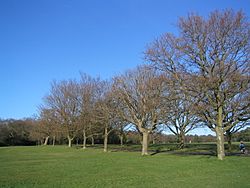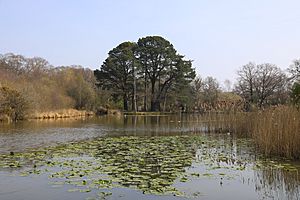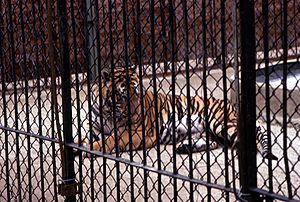Southampton Common facts for kids
Quick facts for kids Southampton Common |
|
|---|---|

Southampton Common, January 2005
|
|
| Type | Common land / Public park |
| Location | Southampton |
| Area | 365 acres (1.48 km2) |
| Created | Unknown. First documented 13th century as common land 1844 as public park |
| Operated by | Southampton City Council |
| Open | All year |
| Status | Green Flag Award Site of Special Scientific Interest |
Southampton Common is a huge open park located just north of the city centre in Southampton, England. It's surrounded by areas like Shirley, Bassett, Highfield, and Portswood. This amazing space is home to lots of different animals and plants. It even has the biggest known group of the rare great crested newt! Because of its special wildlife, it's officially called a Site of Special Scientific Interest (SSSI). People use the Common for many fun community events, like the Flower Festival and the Race for Life, which helps Cancer Research UK.
What You'll Find at Southampton Common
Southampton Common is a really big place, covering about 365 acres (which is about 1.5 square kilometers). It has many different areas for everyone to enjoy.
Fun Areas to Explore
- Woodlands and Parkland: There are beautiful wooded areas and open grassy spaces perfect for walking or playing.
- Ponds and Wetlands: You'll find peaceful ponds and wet areas that are home to lots of wildlife.
- Nature Trails: Follow the paths to discover different parts of the Common and see nature up close.
- Paddling Pool and Play Area: At the south-east end, there's a recently updated paddling pool and a fun play area for kids. It's close to a car park and the historic Cowherds Inn.
- Lakes: There's a special lake for model boats and another for fishing.
Wildlife and History Hub
The Hawthorns Urban Wildlife Centre is at the southern end of the Common. It's built where the Southampton Zoo used to be. Inside, you can learn all about the local wildlife and the history of the area. It has cool interactive displays and information about how the environment is managed.
Historic Cemetery Lake
To the west, next to Hill Lane, is a historic cemetery. This cemetery is also special because it has many rare plants and animals. Cemetery Lake, located here, is a popular spot for birdwatching.
The Avenue Road
A main road, known as The Avenue, cuts through the Common. It connects Southampton to Winchester. This road was straightened way back in 1760. Trees have been planted along it since at least 1763, making it a scenic route.
Streams and Waterways
Several small streams flow through the Common. They are all part of the Rollesbrook system. One stream even connects to the ornamental lake. The main Rollesbrook stream starts at the northern end of the Common and flows southwest, passing under The Avenue and joining other smaller streams before leaving the area near the cemetery.
History of Southampton Common
People have lived in and used the area around Southampton Common for a very long time. Stone tools from the Stone Age have been found here! It's thought that this land has been a "common" (meaning land shared by everyone) since around 500 AD, when the town of Hamwic existed.
The first written records about Southampton Common date back to the 13th century. There was a disagreement over land rights between a local lord and the people of Southampton. In 1228, they agreed that the people living in Southampton could use the Common.
Being "Common Land" meant that all householders in the town could use it. They could collect wood for fuel, clay, berries, and other natural foods. They also used it to graze their animals, like cows. A person called the "cowherd" was in charge of looking after the cattle and maintaining the fences and gates. This job was often passed down through families, and sometimes even women held the position!
Changes Over Time
By the mid-1500s, more people lived in Southampton, so families were limited to having only two animals on the Common. Around this time, people started making bricks on the Common. The brick-making areas moved over the years as the clay ran out.
In 1595, there was an early attempt to bring water to Southampton from the Common, but it didn't work very well.
The Cowherds Inn and Public Use
From the mid-1700s, fewer animals grazed on the Common. The cowherd's house was rebuilt in 1762. To help pay for it, the cowherd started selling drinks and snacks. Eventually, the house became an inn, which is now the Cowherds Inn.
For a while, the town's gallows (where criminals were executed) were located on the north side of the Common. The last execution there was in 1785.
The 1800s: Parks, Races, and Water
In 1814, a house called Hawthorn Cottage was built on the Common. It was lived in until 1942.
A racecourse was built on the Common in 1822, but it wasn't very popular and stopped being used by 1848. Later, in 1860, a new racecourse was built, and races continued until 1881. Cricket and golf were also played on the Common during this time.
In 1843, part of the Common was set aside to become a cemetery, which opened in 1846 and is now known as Southampton Old Cemetery. More land was added to the cemetery in later years.
The Common officially became a public park in 1844, meaning it was open for everyone to enjoy.
Lakes and Reservoirs
The first natural pond on the Common appeared between 1800 and 1846. Later, a disused gravel pit filled with water and became a rough pond. In 1881, this was tidied up to form Cemetery Lake.
In 1888, the council decided to create a second lake, called the ornamental lake. It was built in a crescent shape with two levels and a waterfall.
Water Supply for the City
In the 1800s, several reservoirs were built on the Common to supply water to Southampton. The first one was behind the Cowherds Inn in 1803. More reservoirs were added later.
In 1835, they tried to dig a deep artesian well on the Common to find water, but it was a difficult project and only produced small amounts of water. Work on it continued off and on until 1883, reaching a depth of over 400 meters.
In 1850, two more reservoirs were built to hold water from the River Itchen. Water stopped being brought from the river in 1892, and these reservoirs were covered in 1895. The first reservoir behind the Cowherds Inn was filled in 1871. The others were used for watering roads and, from 1894, for sailing model yachts.
The 1900s: Wars and Changes
During World War 1, the military took over much of the Common. They built many huts and used it as a rest camp for troops before they left the country from the Port of Southampton. The Common was returned to the council in 1919.
In the 1920s, football became very popular on the Common, with 30 pitches in use!
During World War 2, the military again used the Common as a camp for allied forces and even a prisoner of war camp. After the war, some of the huts were used by people who didn't have homes. The last of these huts were cleared in 1953.
Hawthorn Cottage, which had been empty since 1942, was bought by the council in 1945. It was in poor condition, so it was knocked down, and the area became a tree nursery.
From 1947, the annual Southampton Horticultural Show (later called the Southampton Show) was held on the Common. In 1988, it became the Balloon & Flower Festival.
In 1961, the Southampton zoo opened on the Common, on the site of the former Hawthorn Cottage. However, conditions at the zoo led to protests in the early 1980s, and it closed in 1985. The site was then used to build the Hawthorns Urban Wildlife Centre.
In 1968, the council wanted to build two new car parks on the Common. Local groups challenged this in court, and it was found that driving motor vehicles on the Common was generally illegal. To fix this, a new law was passed in 1971, allowing vehicles for maintenance and events.
In the early 1980s, the ornamental lake was cleaned out, which unfortunately harmed some of the wildlife. However, a plan to do the same to the boating lake was stopped by the Nature Conservancy Council.
Water Features Update
In 1919, after two people drowned, the model yacht lake (formerly the third reservoir) was made shallower. It was supplied by and drained into the Rollesbrook stream.
Between 1934 and 1937, the second reservoir was turned into a paddling pool with a fountain. It was mostly filled with fresh water from the town's supply.
During World War 2, maintenance on the ornamental lake stopped, and it became overgrown. The military also blocked much of the drainage system.
In 1952, the two covered reservoirs were combined into one. In the 1980s, the banks of the island on Cemetery Lake were strengthened to prevent erosion.
The 2000s: Modern Events
The Balloon festival stopped being held after 2005.
The Common People music festival was held on the Common for four years, starting in 2015. The band Alt-J even mentions the Common in their song Bloodflood.
Today, the Common is also a popular spot for Parkrun, a free weekly 5 km run held every Saturday morning near the Hawthorns Centre.
Images for kids




